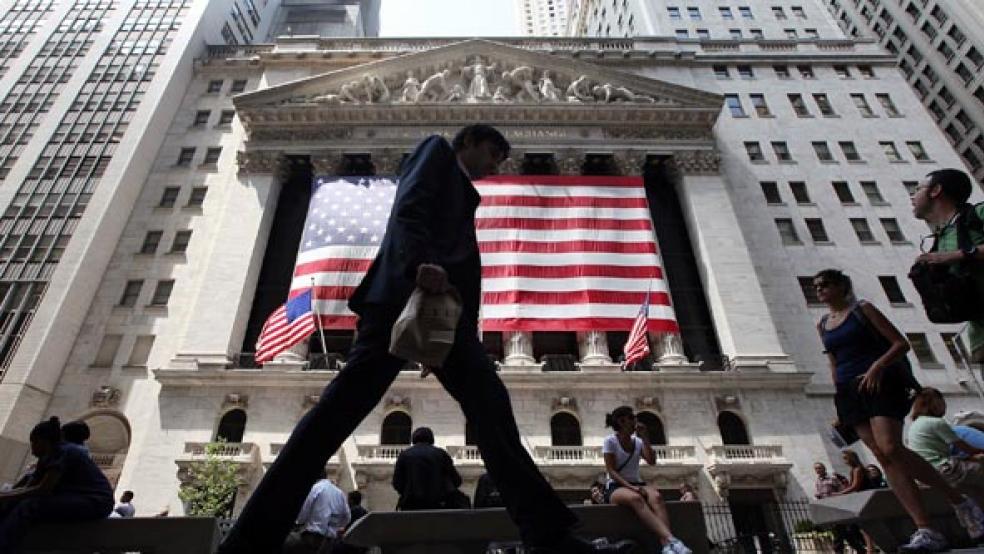What little difference a year makes. On August 5, 2011 — one year ago today — Standard & Poor's shook global markets and rattled the U.S. political establishment by downgrading the federal government's credit rating from AAA to AA+.

Yet despite the high drama surrounding the move, dramatically little has changed in terms of the fiscal and political issues S&P pointed to in making its move.
The downgrade followed a divisive debate over the debt ceiling in Washington, and it capped a tumultuous time on Wall Street. The recommendations of the bipartisan commission headed by Erskine Bowles and Alan Simpson had been largely ignored. Instead, President Obama and Republicans in Congress became bogged down in an ugly and prolonged battle over raising the nation’s debt limit and reducing the deficit. The agreement they reached at the eleventh hour averted a possible default but fell short of what S&P analysts deemed necessary to stabilize the country’s fiscal future.
For investors, worries about Europe — particularly Spain and Italy — were mounting quickly. On the day before the S&P announcement, spooked investors drove the S&P 500 stock index nearly 5 percent lower. The European Central Bank stepped in to buy government bonds in hopes of stemming the spiraling debt crisis — as it did again this week. Investors were left disappointed and skeptical about whether the authorities were acting forcefully enough — as they were again this week. In all, the market had plunged more than 10 percent over a span of two weeks.
In many respects, the global economic situation has gotten worse since then. “At that time, we were in what looked to be the early stages of a recovery,” says Brett Rose, an interest rate strategist at Citigroup. “Europe was a concern but not a front-burner concern at that point. Both of those things have changed dramatically since then.” But many, if not all, of the major economic concerns that dominated the headlines last August are still in play. And lawmakers are still kicking around a deficit-reduction plan along the lines proposed by the Bowles-Simpson commission nearly two years ago.
On the day of the downgrade, the rumors started early but the news came late. That Friday, shortly after 10:30 a.m., a blogger at The Wall Street Journal noted the percolating buzz: “It's out there on other blogs now, so we might as well address it,” he wrote of the chatter that S&P would announce its downgrade after the end of trading. The reporter, Mark Gongloff, added that a ratings cut “would be an extraordinarily brazen move” that would make S&P “more universally hated than LeBron James's Miami Heat. Dow[n]grade the US after the bell on an August Friday in the middle of the worst market chaos since 2008? The political hellstorm would curl your hair from five miles away.”
The hellstorm hit at 8:13 p.m., when S&P announced its cut. Though it was unprecedented, the downgrade wasn't really a surprise. S&P had warned twice in the months leading up to its move that if President Obama and Congress failed to work out a credible long-term plan for reducing the national debt, it would follow through with the downgrade.
While most analyses largely dismissed the dangers of the S&P downgrade — and many pointed out that the credit rating agencies didn’t have much credibility left given their track record before the financial crisis — some had warned that it could increase borrowing costs for the government, among other potential effects.
But the yield on 10-year Treasuries has fallen about one percentage point, from 2.58 percent last year to 1.56 percent now — and has been as low as 1.43 percent in recent days. “The U.S. continues to be, for better or for worse, considered a relative safe haven,” says Ted Weisberg, the founder of Seaport Securities. “You see that reflected in treasuries and in continued demand for treasuries even though the interest rates remain basically zero.”
Bond investors have had few attractive alternatives. “At this point, you’ve got almost no sovereigns remaining that you could say are entirely pristine,” Rose says. Switzerland and some Scandinavian countries would be exceptions to that, he says, but their bond markets are relatively small.
U.S. stocks, meanwhile, certainly haven’t suffered because of the downgrade. The Standard & Poor’s 500-stock index has chugged 16 percent higher over the last 12 months, albeit in fits and starts.
Still, those gains don’t mean that investors are sanguine about the U.S. situation, fiscal or political. “It doesn’t mean it’s not a problem,” Citi’s Rose says. “It just means that it’s being overwhelmed by other issues in the near term. Investors still have concerns that the long-term fiscal situation in the U.S. is unsustainable, but in the near-term you’ve got far more concerns about countries such as Spain or Italy, and the weakness in growth in the U.S., Europe and globally.”
In explaining the downgrade, Standard & Poor’s pointed to U.S. fiscal policy, including the specifics of the agreement to resolve the debt-ceiling debacle. “The downgrade reflects our opinion that the fiscal consolidation plan that Congress and the Administration recently agreed to falls short of what, in our view, would be necessary to stabilize the government's medium-term debt dynamics,” S&P’s analysts wrote.
But the rating agency made clear that its move was also a condemnation of the dysfunctional politics behind those debt dynamics. “More broadly, the downgrade reflects our view that the effectiveness, stability, and predictability of American policymaking and political institutions have weakened at a time of ongoing fiscal and economic challenges to a degree more than we envisioned when we assigned a negative outlook to the rating on April 18, 2011.”
“Since then, we have changed our view of the difficulties in bridging the gulf between the political parties over fiscal policy, which makes us pessimistic about the capacity of Congress and the Administration to be able to leverage their agreement this week into a broader fiscal consolidation plan that stabilizes the government's debt dynamics any time soon.”
“The rating agency actually did this country a huge favor,” says Weisberg, “because it sent a very very strong message to the politicians to stop what you’re doing and clean up your balance sheet.”
With a presidential election looming, the message has essentially been ignored. “Nothing has changed,” Weisberg says wistfully. “Nothing has changed.”
Not that officials didn’t respond to the downgrade. Even before S&P’s officially announced the downgrade, Treasury officials went back and forth with the ratings agency, pointing out a $2 trillion mistake in its analysis. S&P went ahead with the downgrade anyway, prompting a blistering response:
“Independent of this error, there is no justifiable rationale for downgrading the debt of the United States,” John Bellows, then the Treasury Department’s acting assistant secretary for economic policy, wrote in a blog post the next day. “There are millions of investors around the globe that trade Treasury securities. They assess our creditworthiness every minute of every day, and their collective judgment is that the U.S. has the means and political will to make good on its obligations. The magnitude of this mistake – and the haste with which S&P changed its principal rationale for action when presented with this error – raise fundamental questions about the credibility and integrity of S&P’s ratings action.”
President Obama addressed the downgrade the following Monday, noting in a speech from the White House state dining room that S&P had proceeded with the cut “not so much because they doubt our ability to pay our debt if we make good decisions, but because after witnessing a month of wrangling over raising the debt ceiling, they doubted our political system’s ability to act.”
Obama went on to acknowledge the fiscal and political issues, according to a transcript on the White House website, before adding that, “Our problems are eminently solvable.” Obama pointed to the spending cuts agreed to as part of the debt-ceiling deal and suggested that, “What we need to do now is combine those spending cuts with two additional steps: tax reform that will ask those who can afford it to pay their fair share and modest adjustments to health care programs like Medicare.”
The president also said he hoped that the downgrade would lend a “renewed sense of urgency” to the Super Committee tasked with devising a long-term budget plan as part of the agreement to raise the debt ceiling last year. “I assure you,” Obama said, “we will stay on it until we get the job done.”
The super committee, of course, failed to reach an agreement, meaning that $1.2 trillion in automatic cuts of defense and other programs are set to take place as of next year. Those changes, combined with the tax cuts also set to expire at the end of the year, have left the country approaching a “fiscal cliff” at the end of the year – an added dose of uncertainty at a time when the economic recovery appears to be slowing.
“Markets can deal with good news, markets can deal with bad news,” says Weisberg. “What markets cannot deal with is uncertainty. And the markets, unfortunately, are hostage to the politicians both in the U.S. and in Europe.”
RELATED: 10 'Kicked Cans' That Can Send the U.S. Over the Cliff
S&P also still sees increased political polarization as a threat to fiscal progress. “[W]e think that recent shifts in the ideologies of the two major political parties in the U.S. could raise uncertainties about the government’s ability and willingness to sustain public finances consistently over the long term,” S&P noted in a June report reaffirming its AA+ rating and negative outlook.
And given the depth of the political quagmire, S&P’s ratings analysts don’t place much faith in the idea that the election could finally lead to decisive action. “Although the 2012 elections could resolve the U.S. fiscal debate, we see this outcome as unlikely,” S&P’s June report said. “If, as commentators currently expect, the election is close, the race could, in our view, reduce bipartisanship from its already low level as each side strives to rally support by more clearly distinguishing itself from the other.”





